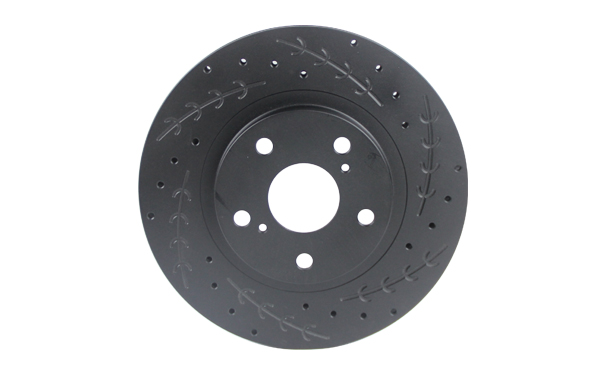Brake disc wear is a common problem in vehicle braking systems, which directly affects the safety and driving experience of the vehicle. As one of the core components of the braking system, the brake disc mainly functions to slow down or stop the vehicle through friction with the brake pads. As the usage time increases, the brake disc will gradually wear out. If not maintained or replaced in a timely manner, it may cause a series of problems. The following will analyze in detail the impact of brake disc wear, including safety, performance, economy, and driving experience.
1. The direct impact of brake disc wear is the decrease in braking performance. When the surface wear of the brake disc is uneven or the thickness decreases, the contact area between the brake pads and the brake disc decreases, the friction force decreases, and the braking force weakens. Especially during emergency braking or high-speed driving, the braking distance will significantly increase, increasing the risk of traffic accidents. In addition, severely worn brake discs may experience a "slip" phenomenon, where the brake pads cannot effectively grip the brake discs, resulting in the vehicle being unable to slow down or stop in a timely manner.
2. Brake noise and vibration: When the brake disc wears unevenly or has scratches or grooves, the friction between the brake pads and the brake disc will produce abnormal noise, such as sharp "squeaking" or "buzzing" sounds. This kind of noise not only affects the driving experience, but may also be a warning signal of brake system problems. In addition, worn brake discs may cause significant vibrations in the steering wheel or body during braking, a phenomenon commonly known as "brake shake". Braking jitter not only affects driving comfort, but may also impose additional burdens on the vehicle's suspension and steering systems.
3. Shortening the lifespan of brake pads can accelerate the wear of brake discs. When the surface of the brake disc is uneven or the thickness is uneven, the brake pads will generate irregular friction with the brake disc, leading to increased wear of the brake pads. This not only increases the frequency of replacing brake pads, but may also lead to premature failure of brake pads, further affecting braking performance. In addition, worn brake discs may cause local overheating of brake pads, increasing the risk of brake pad cracking or detachment.
4.When the brake system overheats and the brake disc wears severely, its heat dissipation performance will significantly decrease. When braking frequently or driving downhill for a long time, the brake discs and pads generate a large amount of heat. If the brake disc cannot effectively dissipate heat, it may cause the brake system to overheat and even lead to brake failure. In addition, overheating may also cause deformation of the brake disc, further exacerbating brake shake and noise issues.
5. Decreased vehicle handling and worn brake discs can affect the vehicle's handling. For example, when driving on a bend, if the brake discs wear unevenly, it may lead to uneven braking force between the left and right wheels, causing the vehicle to experience uneven braking. This not only affects driving stability, but may also lead to vehicle loss of control, especially on wet or icy roads. In addition, worn brake discs may cause slow braking response, affecting the driver's control of the vehicle.

6. Increasing maintenance costs: If brake disc wear is not dealt with in a timely manner, it may lead to more serious brake system failures, thereby increasing maintenance costs. For example, worn brake discs may cause excessive wear or damage to components such as brake calipers and brake cylinders. In addition, if the brake disc is severely worn and cannot be repaired, a new brake disc must be replaced, which will bring additional economic burden. Therefore, regularly checking the wear of brake discs and replacing them in a timely manner can effectively reduce maintenance costs.
7. Safety hazards: When the brake disc is severely worn, it may cause a series of safety hazards. For example, in emergency situations, excessive braking distance may lead to rear end collisions; Brake shaking may cause the driver to lose control of the vehicle; Overheating of the braking system may cause brake failure. These safety hazards not only threaten the lives of drivers and passengers, but may also pose a threat to other road users.
8. Environmental impact: Brake disc wear will generate more metal dust, which will spread through the air and cause pollution to the environment. In addition, worn brake discs may lead to reduced braking efficiency, increased fuel consumption and exhaust emissions, further exacerbating environmental pollution.
9. Decreased driving experience. Brake disc wear can affect the driver's driving experience. For example, braking noise and shaking can make people feel uncomfortable, and slow braking response can make people feel uneasy. In addition, frequent maintenance and replacement of brake discs can also bring inconvenience and economic pressure to drivers.
10. If brake disc wear is not dealt with in a timely manner, it may lead to a decrease in overall vehicle performance and affect the vehicle's resale value. Potential buyers may have doubts about the overall condition of the vehicle if they find severe wear on the brake discs during inspection, leading to lower prices or giving up on the purchase.
How to determine brake disc wear? In order to promptly detect brake disc wear issues, drivers can pay attention to the following signs: abnormal noise or vibration during braking. -The braking distance has significantly increased. -There are obvious scratches, grooves, or cracks on the surface of the brake disc. -There are obvious protrusions or indentations on the edge of the brake disc. -Uneven or premature wear of brake pads.
How to prevent and solve brake disc wear? -Regular inspection: It is recommended to check the brake disc every 10000 to 20000 kilometers to ensure that its thickness and surface condition meet the requirements. -Timely replacement: When the brake disc wears down to a small thickness or shows serious scratches or cracks, it should be replaced in a timely manner. -Avoiding sudden braking: Reducing sudden braking and prolonged braking can effectively extend the service life of brake discs. -Choose high-quality accessories: Using high-quality brake discs and pads can improve the performance and durability of the braking system.
Brake disc wear has a significant impact on the safety, performance, economy, and driving experience of vehicles. Drivers should regularly check the wear of brake discs, maintain or replace them in a timely manner to ensure the normal operation of the braking system. By taking effective preventive measures, the service life of brake discs can be extended, maintenance costs can be reduced, and driving safety can be ensured.
手机:13964587298 / 18354519598
在线QQ:381214835
电话:0535-2836718
E-mail:381214835@qq.com
地址:莱州市土山镇工业园
